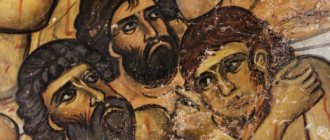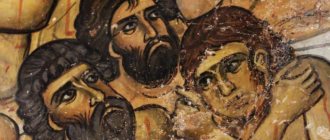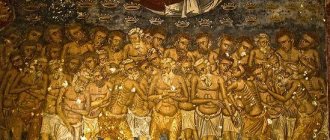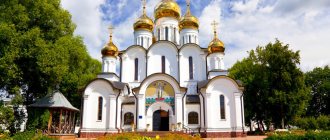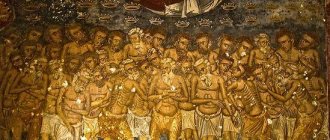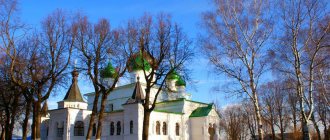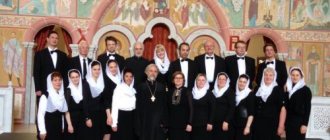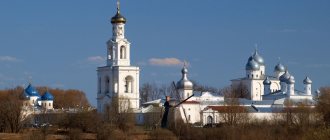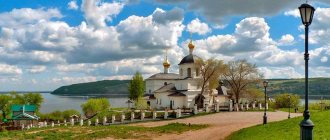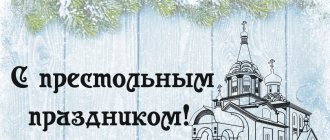History of the construction of the Church of the Forty Martyrs of Sebaste
According to historical information, the wooden Church of the Forty Martyrs has stood at the mouth of Trubezh since 1628.
A little later, in 1652, a second church appeared in Rybnaya Sloboda at the Sorokosvyatsky Church, consecrated in honor of the Intercession of the Most Holy Theotokos. There were 82 households in her parish. By the 20s of the 18th century, both churches had become very dilapidated.
And the local priest Ivan Stefanov and his parishioners, with permission from the authorities, built two new wooden churches by 1728. The cold church began to be called Sorokosvyatskaya, and the warm church - Intercession.
In 1775, instead of these two wooden churches, a new one made of brick was erected. These were the heydays of stone church architecture. The newly built church at that time had about 200 parishioners. Since then, the tradition has been preserved in the Sorokosvyatsky Church. Her cold throne is named in honor of the Forty Martyrs of Sebaste, and the warm throne is dedicated to the Intercession of the Most Holy Theotokos.
Money for the construction of the temple was given by merchants from Moscow, brothers Maxim and Ivan Shchelyagin. They began their trade in Pereslavl, but later, like the merchants Obukhovs and Kholshchevnikovs, they moved to the capital.
History[edit]
No information has been preserved about the exact date of the founding of the parish in the Fisherman's Settlement of Pereslavl-Zalessky, but there was a church already at the beginning of the 17th century. In the patriarchal salary books for 1628 it is written: “Church of the Holy Forty Martyrs in the Posad... tribute eight altyns, four money, ten-dollar hryvnia.”
In 1652, another warm church was built next to this church and consecrated in honor of the Intercession of the Most Holy Theotokos. In the scribe books of 1653, 82 households were recorded in the parish at these churches. In the census books of 1703, the priest Father Joachim (Semyonov) is listed with them, in the parish “82 courtyards, church arable land tithe and a third, hay 9 kopecks.”
In 1726-27, both wooden churches - both cold and warm - turned out to be dilapidated, it became impossible to serve in them, and at the request of the priest Father John (Stefanov) and his parishioners, it was allowed to build new wooden churches, which were built and consecrated in 1728 . The cold church was consecrated in the same name of the Holy Sebastian Martyrs, and the warm one - in honor of the Nativity of the Blessed Virgin Mary.
Instead of these two wooden churches, in the second half of the 18th century, during the period of the rise of church construction, a stone church was built in 1755 at the expense of Moscow merchants Maxim and Ivan Shchelyagin, which now exists. There are two altars in it: in the cold one in honor of the Holy Forty Martyrs of Sebaste, and in the warm chapel - in honor of the Nativity of the Blessed Virgin Mary. There were about 200 people in the church parish at that time.
In 1805, Father Nikita (Bessonov Nikita Ilyich), who had previously been a teacher and later an inspector of the Pereslavl Theological School, was assigned to the Church of the Holy Forty Martyrs of Sebaste. In 1824, he was appointed rector of the Transfiguration Cathedral in Pereslavl and elevated to the rank of archpriest.
In 1812, Father John (Filippovsky Ivan Kuzmich), after graduating from the theological department of the Vladimir Theological Seminary, became a priest of the Church of the Holy Forty Martyrs of Sebaste; Father John died on April 15, 1865.
The land that used to belong to the church, shown in the scribe books, was taken over by the state department in 1846, which includes Rybnaya Sloboda.
Since 1850, Father Andrei (Andrei Ivanovich Sakharov) was appointed priest to the church. In 1866 he was transferred to the Smolensk Church of Pereslavl-Zalessky, and died on October 14, 1889.
Read more…
The Feat of the Forty Martyrs
The history of the exploits of the early Christians, in whose honor the throne of this church was consecrated, is interesting and instructive. They were warriors in the army of Rome. The events took place in 320 AD, when the detachment stopped near the city of Sebastia, in Lesser Armenia, which was then one of the Roman provinces. Now these lands are located in Turkey.
According to the customs of that time, a sacrifice ceremony was to take place during the pagan holiday. The Roman pagan commander Agricolaus decided that he would force 40 of his Christian warriors from Cappadocia to perform sacrifices. But they didn't agree.
And although in Rome since 313 the Christian faith was no longer officially prohibited, Agricolaus locked the soldiers in prison with threats and promises to get them to renounce Christ. About a week of persuasion did not lead to any results.
Then Agricolaus ordered the soldiers to be taken to the lake near Sebastia. It was winter. The Christians were stripped naked and forced to stand on the lake ice. In the morning, although they were icy, they were still alive. Then the Romans killed them. The martyrdom of these Christians who did not betray their faith has become a legend.
Temple of the Forty Martyrs of Sebaste
Description
In 313, Saint Constantine the Great issued a decree according to which Christians were allowed freedom of religion and were given equal rights with pagans.
But his co-ruler Licinius was a convinced pagan and in his part of the empire he decided to eradicate Christianity, which had spread significantly there. Licinius was preparing for war against Constantine and, fearing treason, decided to clear his army of Christians. At that time, in the Armenian city of Sebastia, one of the military leaders was Agricolaus, a zealous supporter of paganism. Under his command was a squad of forty Cappadocians, brave warriors who emerged victorious from many battles. They were all Christians. When the warriors refused to sacrifice to the pagan gods, Agricolaus imprisoned them. The soldiers indulged in fervent prayer and one night they heard a voice: “He who endures to the end will be saved.”
The next morning the soldiers were again brought to Agricolaus. This time the pagan used flattery. He began to praise their courage, youth and strength and again invited them to renounce Christ and thereby gain the honor and favor of the emperor himself. Hearing a refusal again, Agricolaus ordered the soldiers to be chained. However, the eldest of them, Kirion, said: “The Emperor did not give you the right to impose fetters on us.” Agricolaus was embarrassed and ordered the soldiers to be taken to prison without shackles.
Seven days later, the noble dignitary Lysias arrived in Sebastia and held a trial of the soldiers. The saints firmly answered: “Take not only our military rank, but also our lives, for us there is nothing dearer than Christ God.” Then Lysias ordered the holy martyrs to be stoned. But the stones flew past their target; a stone thrown by Lysias hit Agricolaus in the face. The torturers realized that the saints were protected by some invisible force. In prison, the soldiers spent the night in prayer and again heard the voice of the Lord comforting them: “He who believes in Me, even if he dies, will live. Be bold and do not be afraid, for you will receive imperishable crowns.”
The next day, the trial before the torturer and the interrogation were repeated, but the soldiers remained adamant.
It was winter, there was severe frost. They stripped the holy warriors, led them to a lake located not far from the city, and placed them under guard on ice for the whole night. To break the will of the martyrs, a bathhouse was lit nearby on the shore. In the first hour of the night, when the cold became unbearable, one of the warriors could not stand it and ran towards the bathhouse, but as soon as he crossed the threshold, he fell dead. At three o'clock in the morning, the Lord sent consolation to the martyrs: suddenly it became light, the ice melted, and the water in the lake became warm. All the guards were asleep, only one named Aglaius was awake. Looking at the lake, he saw that a bright crown had appeared over the head of each martyr. Aglaius counted thirty-nine crowns and realized that the fleeing warrior had lost his crown. Then Aglaius woke up the rest of the guards, took off his clothes and told them: “And I am a Christian!” - and joined the martyrs. Standing in the water, he prayed: “Lord God, I believe in You, in whom these soldiers believe. Join me to them, so that I may be worthy to suffer with Your servants.”
The next morning the torturers were surprised to see that the martyrs were alive, and their guard Aglaius was glorifying Christ with them. Then the soldiers were taken out of the water and their legs were broken. During this painful execution, the mother of the youngest of the warriors, Meliton, urged her son not to be afraid and to endure everything to the end. The bodies of the martyrs were placed on chariots and taken to be burned. Young Meliton was still breathing, and he was left lying on the ground. Then the mother picked up her son and carried him on her shoulders after the chariot. When Meliton breathed his last, his mother laid him on a chariot next to the bodies of his holy companions. The bodies of the saints were burned at the stake, and the charred bones were thrown into the water so that Christians would not collect them.
Three days later, the martyrs appeared in a dream to Blessed Peter, Bishop of Sebaste, and ordered him to bury their remains. Together with his assistants, he collected the holy relics one by one and interred them with prayer. The names of the martyrs have been preserved: Kirion, Candide, Domnus, Hesychius, Heraclius, Smaragdus, Eunoicus, Valens, Vivian, Claudius, Priscus, Theodulus, Eutyches, John, Xanthius, Ilian, Sisinius, Haggai, Aetius, Flavius, Acacius, Ecdecius, Lysimachus, Alexander, Elijah, Gorgonius, Theophilus, Domitian, Gaius, Leontius, Athanasius, Cyril, Sakerdon, Nicholas, Valerius, Filictimon, Severian, Hudion, Melito and Aglaius.
The memory of the 40 martyrs who suffered in Lake Sebaste is one of the most revered holidays. On the day of their memory, March 22 according to the new style, the severity of Great Lent is eased and the Liturgy of the Presanctified Gifts is celebrated. This is a permanent holiday, that is, its date is fixed.
In Rus', the church holiday - the day of remembrance of the forty martyrs of Sebaste - was called Zhavoronki or Soroki (with emphasis on the first syllable). The most striking custom of this day is to bake Lenten buns in the shape of birds - “larks”.
History of the Church of the Forty Martyrs of Sebaste in the 20th century
By the beginning of the last century, the walls of the temple were painted by the Pereslavl tradesman V.P. Shemanaev
. However, in the summer of 1919, a large fire occurred inside the building, due to which the wall paintings were badly damaged. It was almost completely covered with a layer of soot.
After the arrival of Soviet power, the temple was under the jurisdiction of the parish council. In 1922, the All-Russian Central Executive Committee decided to confiscate all church valuables to help the starving people of the Volga region. The Metropolitan appealed to the priests and believers not to interfere with the authorities.
The commission for the confiscation of valuables came to the temple, and priest Leonid Gilyarevsky and the parishioners presented it with two sets of liturgical utensils for the two existing church altars. Only thanks to the efforts of the director of the Pereslavl Museum, Mikhail Ivanovich Smirnov, the most valuable things - a silver censer and a 17th-century Gospel framed in a silver frame - avoided confiscation and melting down, and became part of the museum exhibition.
But the fate of M.I. Smirnova, like most people of that time, had a difficult life. In the 30s he was arrested, and he spent three years in the camps of the Turukhansk region. Later, this famous historian worked in Sergiev Posad.
The Sorokosvyatsky Church remained active until the end of the 1930s and had about 150 parishioners. Then the church was closed, and the premises were first used as a library, then for metalworking workshops, and later for a rescue station. Services here resumed in 1996.
Architecture of the Church of the Forty Martyrs of Sebaste
The Church of the Forty Martyrs of Sebaste is often called the Fourty. It looks best from the other bank of the Trubezh River, from the Right Embankment. At the beginning of the 20th century, the beautiful Vvedenskaya Church stood here. And both of these temples formed a picturesque pair, framing the river mouth. But, unfortunately, of the two churches, only one survived, on the left bank.
The basis of the Church of the Forty Martyrs is a traditional massive quadrangle, which is crowned with five domes. Typically, on stone temples, four small domes were installed at the corners of the base. But when erecting the Church of the Forty Martyrs, they did it differently, doing it in a way that was pleasant in wooden architecture. Smaller domes were installed on four pediments built on all sides. And from this the church acquired a picturesque and original appearance.
Compositionally, the building consists of three parts, which are connected to each other and stretched in one line perpendicular to the river. This is the main temple with a semicircular apse, a one-story refectory and a high three-tier bell tower with a high spire. It was added to the church later - already in the 19th century.
The outside of the church is decorated in a very unusual way, and this immediately catches your eye. It has three-row window openings, the platbands on which differ from each other. The bell tower was built in the style of its time and its external decoration also differs from the church itself. Its lower tier is decorated with rusticated walls. And the high arched openings of the two upper tiers are framed by strict semi-columns.
The church ensemble at the mouth of Trubezh is very popular among artists and photographers. Because the bright red church contrasts colorfully with the white details of the window trim and fits very harmoniously into the surrounding landscape.
Current state of the Church of the Forty Martyrs of Sebaste and visiting schedule
The church is now operational and is being actively restored. You can get there on Saturdays from 7.00 to 20.00, and on Sundays and holidays from 7.00 to 15.00.
The icon of the Forty Martyrs of Sebaste with a particle of relics became especially revered by all believers.
The Church celebrates temple and patronal holidays on March 22, 6 Sunday after Easter, September 21 and October 29.
Next to the church there is a modern embankment with benches and lanterns, a small pier and a boat station. This is a favorite diving spot for local children. At the mouth of the river there is an equipped descent to the water. The same staircase goes down to the lake. From here you can see a very beautiful view of Lake Pleshcheyevo - a real dream for photography lovers. True, photography is not allowed inside the church building itself.
How to get to the Church of the Forty Martyrs of Sebaste
The church in Pereslavl-Zalessky is located at the address: st. Left Embankment, 165.
It is better to drive here from the river, along a better road. If the path lies from Moscow, you need to turn left to the earthen rampart, onto Gagarin Street, follow it to Left Embankment Street and go down along the banks of the Trubezh to its mouth.
From the center of Pereslavl-Zalessky it is not difficult to walk to Rybnaya Sloboda on foot (1.5 km). Along the way you can see many houses richly decorated with carvings. It is no coincidence that Rybnaya Sloboda is called the most picturesque part of Pereslavl. There are several bridges across Trubezh, from which it is convenient to choose a convenient angle for photography.
Attraction rating
Rating 4.00 [2 vote(s)]
| ← Yaroslavl region | Pereslavl-Zalessky | Russia → |
How to get there[edit]
The Church in honor of the Forty Martyrs of Sebaste is located within two kilometers from the historical center of Pereslavl-Zalessky - Alexander Nevsky Square. Ways to get there: by car or on foot. Exit from the main road following the sign to Proezdnaya Street. Parking directly next to the Temple may be limited; it is convenient to park a car; a bus is two hundred meters away along Left Embankment Street.
Address:
Pereslavl-Zalessky, Yaroslavl region, st. Left Embankment, building 165
Temple phone number:
+7 (48535) 3 44 83
Telephone number of the rector of the church, Archpriest Ioann Gerasimov:
+7
